#Basidiomycete Fungi
Photo


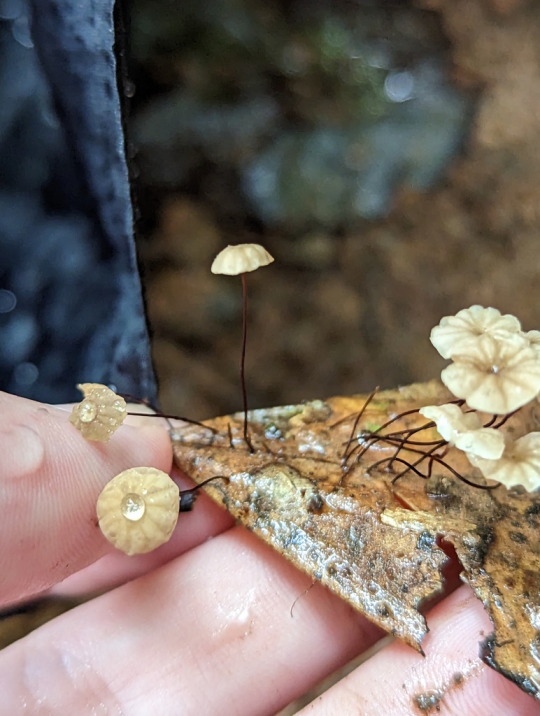
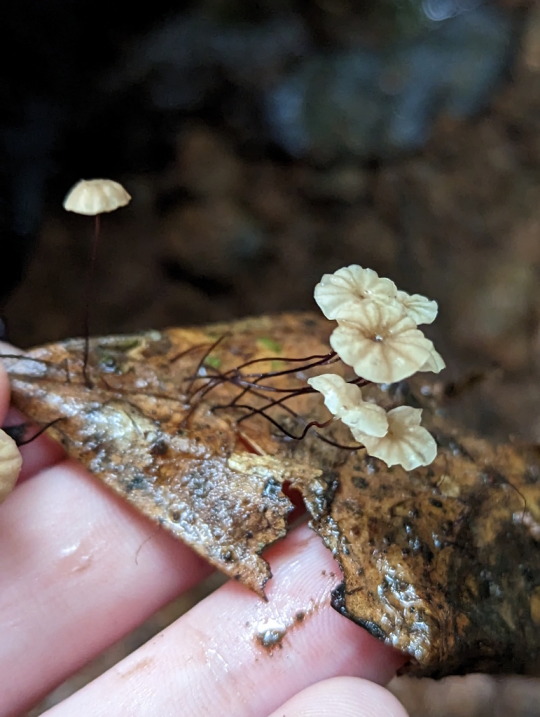
Rainforest Horsehair Mushrooms
Marasmius crinis-equi
22/02/23
#Marasmius crinis-equi#Rainforest Horsehair#Marasmiaceae#pinwheels#Agaricales#Basidiomycota#Basidiomycete Fungi#mushrooms#mushroom#fungi#fungus#mycology
1K notes
·
View notes
Text

Fringed sawgill mushrooms (Lentinus crinitus)
Saint Petersburg, FL
June 2022
#nature#mushrooms#mycelia#mycelium#fungi#fantastic fungi#fungifreaks#fungi fan club#fringed sawgill#florida#basidiomycetes#naturalists
2 notes
·
View notes
Text
Mushroom/mycotumblr! I saw the weirdest crust (?) about a week ago on northeast Ohio and I was looking for explanation 😕

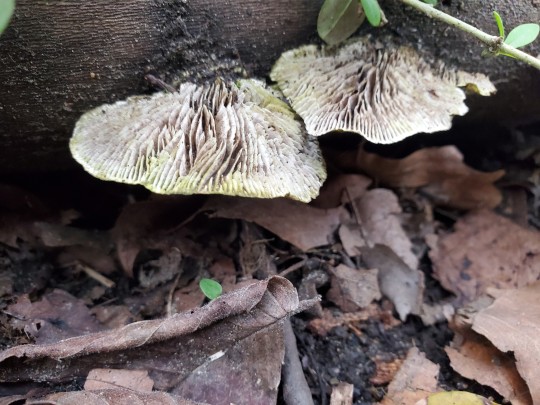
These mushrooms grew with the gills up! Like the whole body! I thought that maybe the log had been turned over and we're really looking at the "bottom" of it, but upon checking the undersides (I don't have a good video or photo, sorry), it truly seems to me like this is just the way they grow. Any ideas, guys? Are they really just growing "upside-down?"
3 notes
·
View notes
Photo

Porcelain fungus (oudemansiella mucida) on a Beech Tree. #autumn #fungi #fungus #basidiomycete #Scotland https://www.instagram.com/p/CjpXIC_g0RZ/?igshid=NGJjMDIxMWI=
1 note
·
View note
Text
[“One of the drivers behind rainfall is something very curious indeed: fungal spores. The group of fungi that produce mushrooms, called basidiomycetes, grow through an osmotic inflation process, their hyphae bonding together and filling with water in order to “bloom” above the soil. Once the mushrooms have developed, tiny stalks (basidia) grow underneath the mushroom cap, culminating in tiny spores. A drop of water forms between the gills under a mushroom’s cap. Finally, the water droplet condenses against the spore, jettisoning the spore out of the mushroom.
In his book Mycelium Running: How Mushrooms Can Help Save the World, mycologist Paul Stamets estimates that the force with which mushrooms eject spores is ten thousand times the force undergone by astronauts as they exit the gravitational pull of Earth’s orbit. Some land many inches away from the original mushroom. But most are buoyed upward by the wind, into the sky. Spores are practically invisible, a shimmer of dust, vaporous. But while they are tiny, they are numerous. More numerous than just about any other organic component in the atmosphere. Every year, around fifty million tons of spores enters into the atmosphere. Some of those spores will immediately land in the dirt and begin, hypha by hypha, to root into the underworld. But millions of tons of spores do something else entirely. Some make it fifty miles up into the air and ride the currents for weeks. They follow the wind. And, like the storm gods, they generate rain. Sugars on the spores’ surface cause water to condense around them once they have been ejected. Spores become a nucleus of sorts in a floating water molecule. These water-coated spores bump into each other, again and again, millions of times, until they accumulate into rain clouds.
In experiments conducted in closed laboratory settings with a variety of different mushrooms, spores created an atmosphere with a relative humidity between 101 and 102 percent, the same oversaturation conditions found in clouds. Researchers concluded that fungi are a key part of a feedback loop in forests and rainy regions. Fungi need damp environments in order to fruit up into reproducing mushrooms. These mushrooms release billions of spores that create clouds. These sporulated clouds, in turn, drop rain down into these environments, creating the perfect mushroom conditions. Whole tropical ecosystems are intimately coordinated by these invisible swarms of spores. Given these facts, we can surmise that as we degrade soil and destroy underground mycelial communities, we are not only harming the ground, we are harming the sky. The source of rain isn’t always above our heads. Sometimes it comes from below our feet.”]
Sophie Strand, from The Flowering Wand: Rewilding the Sacred Masculine
141 notes
·
View notes
Note
Are fungi or mushrooms considered plants? I've heard mixed things & thought you'd have some insight about it. Really love ur ivy concepts!!
I’m not going to just say No! and move on because the truth (at least to me) is REALLY INTERESTING. I drew this out, here’s a few billion years summed up with jokes!
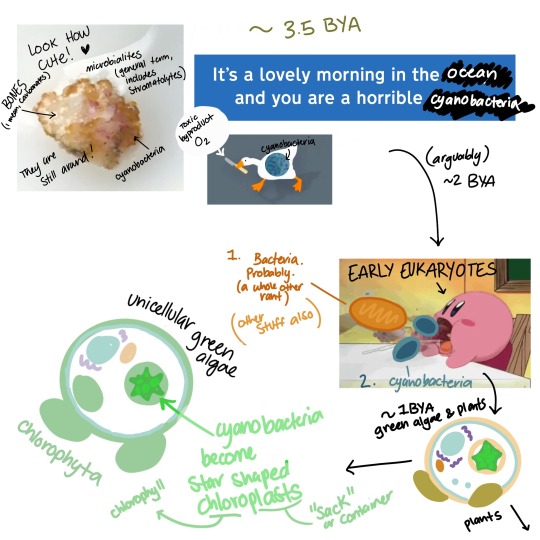
Ok. More than 3.5 BYA. You are a bacteria, living in the oceans (which are blood red but that’s a whole Other Thing). You are a cyanobacteria, you live in big gooey colonies with your best friends and you decide “hey, it would be cool if I could do photosynthesis and get even more energy after I eat the sugars” Which was generally considered a Bad Move, because you made oxygen at the end which is super toxic. To all life. Really bad decision (the oceans helped). Instead of wiping out all life by being horrible and toxic, you actually build the ozone layer and make way for a whole bunch of new guys who can use oxygen (oxygenic respiration).
Now we have eukaryotes depicted as Kirby. This is because they are Like That and when they ate cyanobacteria they didn’t always kill them, and over time they just became chloroplasts. Now they can do photosynthesis. The mitochondria was a similar process that happened first. Some plankton still do this and just… have a guy they didn’t eat all the way.
So we have eukaryote Kirby with chloroplasts. That will split to plants and green algae, here’s where the fungi come in!

The last common fungal ancestor was a parasite of a single called green algae or ancestor, things kind of overlap ranges. So you are a closer “cousin” to fungi than fungi are to plants!
I included this whole thing because I study lichens, and two of the partners in that symbiosis are fungi and/or cyanobacteria. That’s crazy! They were parasites and went and did their own thing and some decided to be symbiotic later! With plants too, they are still pathogens and parasites and so on but doesn’t it seem like living inside a thing that originated by eating all your shit would be a good idea. But lichens have lasted more than 400 million years so who am I to say. And plants have a lot of fungal pathogens but may not have made the transition to land without fungi and would not exist without them.
I could go on. This stuff is my main interest for my scientific career (paired down here ofc) hope this was more interesting than just saying “no!” : )
Bonus: mushrooms are ‘fruiting bodies’ or ‘basidia’ of one division of fungi, the basidiomycetes (buh-sid-ee-oh-my-seats)! ascomycetes (ass-co-my-seats) are usually the cup-shaped ones, not technically mushrooms. I think colloquially mushrooms is used for “edible” fungi and ‘toadstools’ are non-edible.
#asks#botany#fungi#fungi are not plants#they are worse#(affectionate)#green algae#endosymbiosis#chloroplasts#mushrooms#mycology#phycology#phytology
82 notes
·
View notes
Text
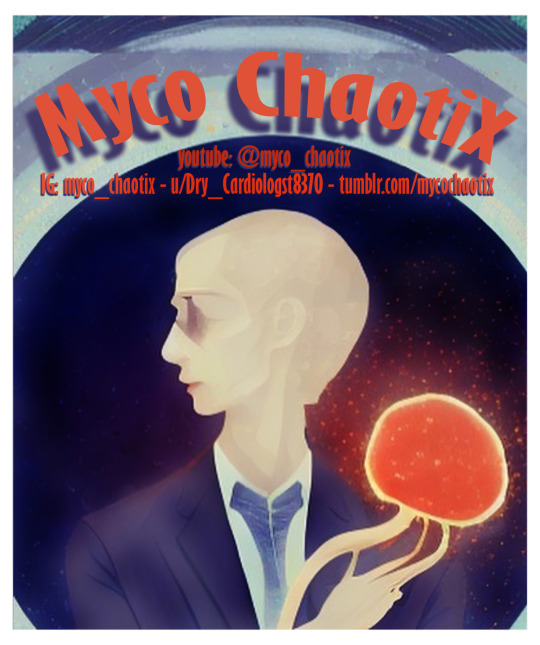
Hey there guys, gals, and non-binary mycopals!
Mycothaotix here, and this shall be my first post on my new, separated tumblr-blog. I was not able to respond to reblog questions and didnt have a way to impliment 'ask's on my previous blog (now titled: 'mycochaos-oldacnt-plzfollownew).
I have some visible old posts under the #mycochaotix tag that I usually use for all posts (and plan to continue to use).
I consider myself a Non-Binary, they/them/he/him mycophile and have started researching and cultivating in late 2021. I also serve as a moderator on the Contamination ID and Myco-advice subreddit r/ContamFam. On that platform, I am known as the Trich Hunter. I have a passion for studying all types of contamination (in addition to primarily researching basidiomycete fungi) because I believe that learning from failures and understanding what to avoid in research efforts are crucial for personal growth and reducing occurrences of contamination.
Please follow for more!
Message me on IG or Reddit with any questions; or to share your mycology successes and failures! 🍄 u/Dry_Cardiologist8370 IG: myco_chaotix Tumblr: myocochaotix
#60s psychedelia#natalensis#lgbtqia#lgbtqia2s#lgbtqia2s+#lgbtqplus#magic mushies#magic mushroom#microbiology#mold#gay#mycochaotix#myco_chaotix#enby#nb#mycology#myc#mycelium#art#fungi art#fantastic fungi#fungi aesthetic#fungicore#fungilove
12 notes
·
View notes
Text
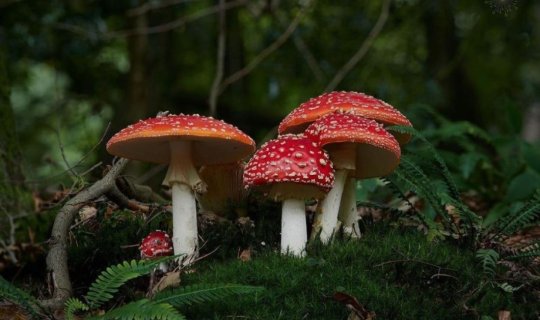
Amanita muscaria, commonly known as the fly agaric or fly amanita, is a basidiomycete of the genus Amanita. Native throughout the temperate and boreal regions of the Northern Hemisphere, Amanita muscaria has been unintentionally introduced to many countries in the Southern Hemisphere, generally as a symbiont with pine and birch plantations, and is now a true cosmopolitan species. It associates with various deciduous and coniferous trees.
Arguably the most iconic toadstool species, the fly agaric is a large white-gilled, white-spotted, usually red mushroom, and is one of the most recognizable and widely encountered in popular culture, including in video games—for example, the extensive use of a recognizable Amanita muscaria in the Mario franchise and its Super Mushroom power-up—and television—for example, the houses in The Smurfs franchise.
Despite its easily distinguishable features, Amanita muscaria is a fungus with several known variations, or subspecies. These subspecies are slightly different, some having yellow or white caps, but they are all usually called fly agarics, and they are most of the time recognizable by their notable white spots. Recent DNA fungi research, however, has shown that some of these variations are not the same species at all, such as the peach-colored fly agaric (Amanita persicina) for example, but the name 'fly agaric' is still commonly used.
Although poisonous, death due to poisoning from A. muscaria ingestion is quite rare. Parboiling twice with water draining weakens its toxicity and breaks down the mushroom's psychoactive substances; it is eaten in parts of Europe, Asia, and North America. All Amanita muscaria varieties, but in particular A. muscaria var. muscaria, are noted for their hallucinogenic properties, with the main psychoactive constituents being muscimol and its neurotoxic precursor ibotenic acid. A local variety of the mushroom was used as an intoxicant and entheogen by the indigenous peoples of Siberia.
More on:Wikipedia
#mushrooms#amanita muscaria#fly agaric#iconic mushroom#fungus#nature#autumn#fall#Northern Hemisphere#poisonous#psychoactive substances#Parboiling twice with water draining#red mushrooms
2 notes
·
View notes
Note
Hey I’m the op from the lichen poll thingy, I really love all the wonderful tags everyone is putting in there and so curious to learn more. Didn’t know a lot about lichen before this, can only ID like 3 of them (wanted to write species but that’s not correct I assume?), so would you care to elaborate what you mean by your tags? Would love to learn!
HELL YES. I hope ur cool w/ me posting this publicly, I take any opportunity I can to gush about lichens. For reference, my tags on that poll were something along the lines of: "do YOU challenge the foundational concept of a species in western science with your existence? well you actually do but not as directly as a lichen." I'm not going to properly cite myself here because I'm lazy so take some things with a grain of salt, but BASICALLY:
- a lichen is a symbiotic relationship between a fungi (typically an ascomycete, though there are a few basidiomycete lichens) and a photosynthetic organism (usually green algae, sometimes cyanobacteria)
- the way we classify lichens, taxonomically, is based on their fungal part, also called a mycobiont. so the species name of a lichen - let's take my fruticose friend Usnea longissima for example - refers only to that fungal part.
- getting a positive species ID on that photosynthetic partner, also called a photobiont, is a lot harder, but we know that there's some overlap between the species of photobionts that different lichen employ
- so why don't we just refer to a lichen based on the mycobiont exclusively?
- because without the photobiont, the mycobiont will not grow into a lichen in any recognizable way. a lichen is NOT a lichen if it is just the fungi species it is named for, and it is not a lichen if it is just free-living algae.
- isn't it cool that some forms of life literally cannot exist as individuals? their existence is predicated on the fact that they are in partnership, inextricably linked from what our conventions of species differentiation would consider an entirely different organism. except, wait: so are we.
- human beings literally cannot function without the bacteria, fungi, and countless other microorganisms living in our intestines, on the surface of our skin, and just about everywhere else. i believe current literature states that >50% of the cells comprising the average human body are nonhuman. your microbiome is the reason you aren't just a tube that constantly leaks out partially-dissolved food matter!
- so who's to say that humans even exist as a distinct species? from a certain perspective, a human being is just an organic scaffold that houses a community of billions of individuals.
- get out there and appreciate your local lichens!!!
#also it's totally okay to refer to the lichens u know how to id as species#while not technically correct it's the framework by which we (people in western science) categorize and recognize them#i just think that biology should be more anarchist on a philosophical level#also ty for asking!!! i love love love to talk about lichens as mentioned previously
14 notes
·
View notes
Text



Ganoderma zonatum
Date taken: June 26, 2023
Location: Northwest Florida
Shot with a Panasonic Lumix DMC-FZ70 using Intelligent Auto mode.
View the iNaturalist observation for this image here.
Taxonomy:
Kingdom: Fungi
Phylum: Basidiomycota (Basidiomycete Fungi)
Class: Agaricomycetes
Order: Polyporales (Shelf Fungi)
Family: Polyporaceae (Bracket Fungi)
Genus: Ganoderma
4 notes
·
View notes
Text
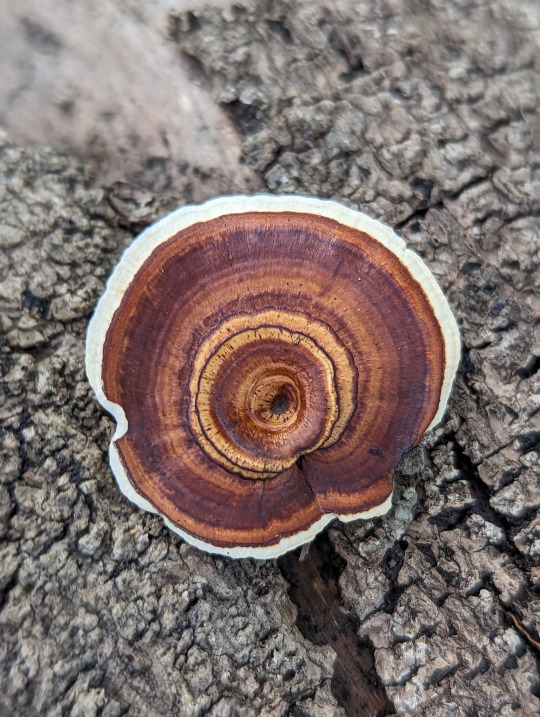
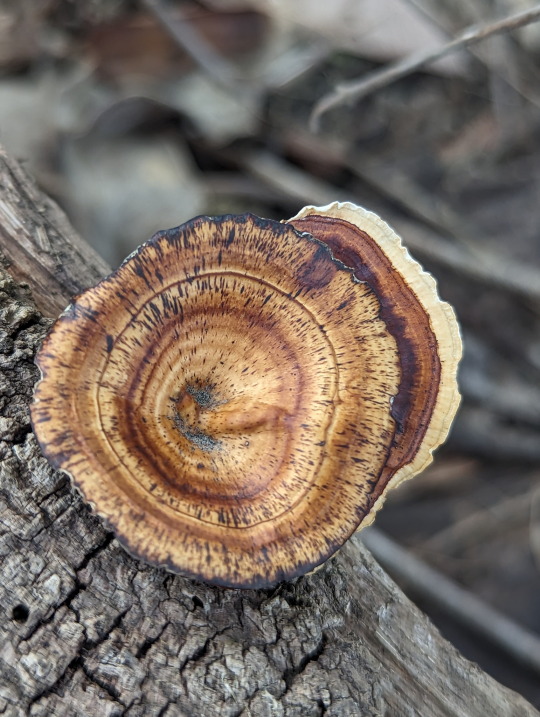
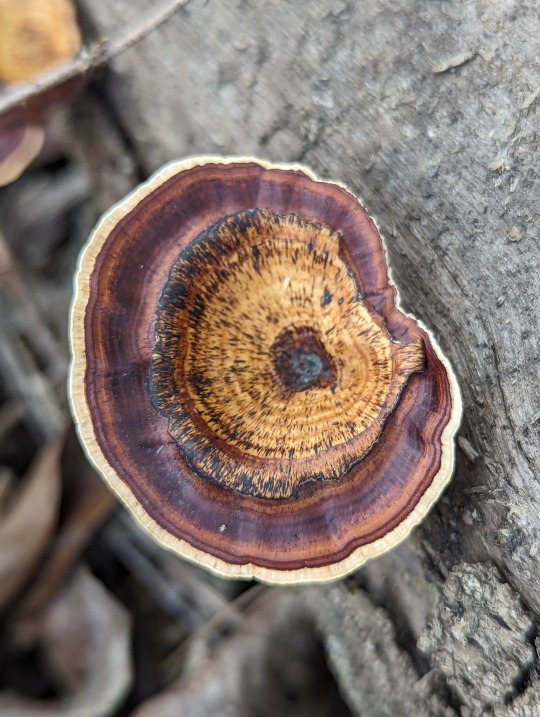

More yellow-stemmed Micropores. These things are everywhere.
24/09/23 - Microporus xanthopus
QLD:WET - El Arish, farmland road
#Microporus xanthopus#Yellow Stemmed Micropore#Polyporales#Shelf Fungi#Basidiomycota#Basidiomycete Fungi#Bracket Fungi#fungi#fungus#mycology
57 notes
·
View notes
Text
Mycelium Morphologies
There are many morphological presentations of mycelium, and each species and variety can have its own patterns of presentation.
Most commonly: rhizomorphic and tomentose, but also effuse, sectored, zonate and variable morphologies are used as descriptors in mycological research!
Mycelium is not an exclusive nutrient seeking colony for just basidiomycetes (most mushrooms), there are classifications of other fungi, ascomycetes and others (to include penicillium, trich, etc) that also have mycelium as part of their reproductive cycle. So, unfortunately sometimes to determine if random mycelial growth on an agar plate is your preferred/intended genetics or contaminant genetics.. you kind of have to wait, or know exactly what your preferred/expected mycelium looks and smells (if u smell test) like. Of course, microscopic confirmation is ultimate determinant if you are able to do so.
Here is link for that: DayTrippers Microscopy library of contam and healthy mycelium examples: https://www.reddit.com/r/ContamFam/comments/nnquol/microscopy_of_healthy_mycelium_and_contamination/
3 notes
·
View notes
Photo
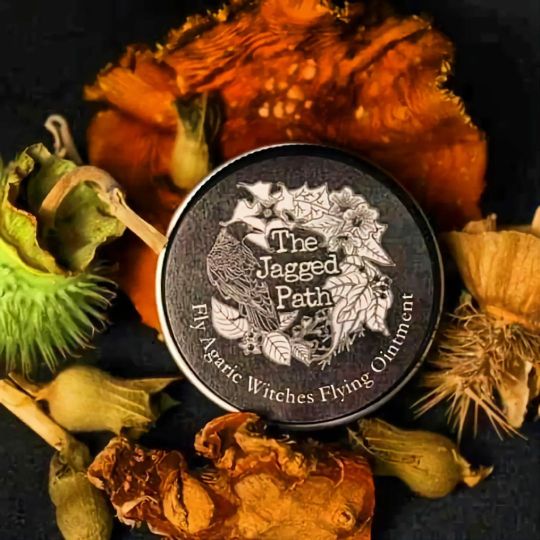
Fly Agaric Witches Flying Ointment⠀ ⠀ Brush off those besoms, Witches. It's time to fly!⠀ ⠀ The solanaceae family allows one’s body to feel separated from the individual; the traveler endures intoxicating sensations, including a sensation akin to flying.⠀⠀⠀⠀⠀ ⠀⠀⠀⠀⠀ Fly agaric is reported to offer the user a feeling of weightlessness, visual and auditory hypersensitivity, space distortion, unawareness of time, and colored hallucinations; feelings of euphoria or invincibility are also oftentimes reported; also used as a sedative aid, leading to a deep sleep with vivid dreams. Ancient tribes and civilizations used hallucinogenic fungi to enter the spirit world.⠀⠀⠀ ⠀ These mushrooms also alter the perception of sight, sounds, etc., (the senses) and change/enhance the feelings and thoughts of the user.⠀⠀ ⠀⠀⠀⠀⠀ Just like my original witches flying ointment, this ointment contains the powerhouse Solanaceae properties of Datura, Atropa Belladonna, Mandrake, and Blk Henbane. Solanaceae relieves chronic pain, joint pain, nerve pain, muscle spasms and cramps, anxiety, issues with sleep, and can aid in restoring lost libido.⠀⠀⠀⠀⠀ ⠀⠀⠀⠀⠀ This formulation also contains the properties of Fly Agaric, a member of the Basidiomycete group of fungi, containing a number of psychoactive compounds: ibotenic acid, muscimol, muscarine, and muscazone (Muscimol is the most significant).⠀⠀⠀⠀ “These statements have not been evaluated by the Food and Drug Administration. This product is not intended to diagnose, treat, cure or prevent any disease. Sold as Curio only." ⠀⠀⠀⠀⠀ #thejaggedpath #controlyourhealth #datura #belladonna #flyagaric #mandrake #solanaceae #bruja #occultherbalism #esoteric #poisonpath #samhain #queerownedandoperated #womanownedbusiness #wisewoman #cunningfolk #wortcunning (at Houston, Texas) https://www.instagram.com/p/CjqkbVhLHh2/?igshid=NGJjMDIxMWI=
#thejaggedpath#controlyourhealth#datura#belladonna#flyagaric#mandrake#solanaceae#bruja#occultherbalism#esoteric#poisonpath#samhain#queerownedandoperated#womanownedbusiness#wisewoman#cunningfolk#wortcunning
4 notes
·
View notes
Note
A destroying angel mushroom, former member of the Fungi Funks... And he left to go solo... Which is successful... Tho he has a hard time socializing because of his "title"...
Creasidi(Amanita Orcreata, a basidiomycete type mushroom, and one of three species with the name "destroying angel".)
2 notes
·
View notes
Text
Mushroom-1:Various faces of mushrooms: important creatures for the earth

Lignin (wiki):skeletal component of wood (later)
Mushrooms and molds are almost identical creatures, neither plants nor animals. Mushrooms are the ones that open the umbrella, and molds are the ones that are not made. About mushrooms from wiki:
@@@@@@@@@@@@@@@
Mushrooms (mushrooms, fungi, buds, mushrooms) are a common name for a relatively large (often protruding) fruiting body or basidiomycete itself among specific fungi (Fungi). Also, the word mushroom is often treated as a general term for specific fungi, but it is originally a structure as described above, not a classification of fungi. Fungi that do not produce fruiting bodies are molds. It is clearly different from plants.
There is no clear standard for "large size" here, but mushrooms are often called mushrooms that are large enough to be seen with the naked eye. Some species are toxic, although they are also used for food and psychological effects. Etymologically, it can be analyzed as "tree + + child"(inJapanese). Many fungi with fruiting bodies of visible size belong to the basidiomycota Basidiomycota or the Ascomycota ascomycota.
In Japan, about 300 species are edible, of which more than a dozen are artificially cultivated with mushrooms. It is said that there are about 2,500 known species and about two to three times as many unknown species in Japan, of which about 200 are well-known poisonous mushrooms, and about 20 are highly addicted or deadly poisonous.
@@@@@@@@@@@@@
Generally, I think it can be defined like this. So how do molds and mushrooms grow? From wiki again:
@@@@@@@@@@@@@
The body (entity) of mushrooms is included in a group of organisms called fungi together with mold. It is a tubular cell line called mycelium, which grows by decomposing and absorbing organic matter with enzymes secreted from the body, producing spores and repeating reproduction.
In the "Encyclopedia of Fungi" of the Japanese Society of Fungi, it is explained that fruiting bodies or basidium fruits are so-called mushrooms, hyphal tissue structures that make sexual reproduction organs, and do not refer to classification groups such as fungi.
In other words, strictly speaking, mushrooms are larger, umbrella-shaped ones. However, it is inaccurate, but it can also refer to the species of the organism that makes it. In other words, by definition, all fruiting bodies are mushrooms, or all organisms that make them are mushrooms. In the latter case, for example, minute punctate objects that are stuck or buried on the surface of dead branches are also regarded as mushrooms. It means that the organisms that are mushrooms look like molds or are yeast-like. There is an example in which the Japanese name is also called "mold" for those having such point-shaped fruiting bodies.
@@@@@@@@@@@@@@

Mushroom life cycle (wiki)
(To be continued)
#mushroom#mold#lignin#fungi#edible#poisonous mushrooms#umbrella-shaped#Mushroom life cycle#rei morishita
2 notes
·
View notes
Text
Instantaneous change in hyphal diameter in basidiomycete fungi
BioRxiv: http://dlvr.it/T2g087
0 notes